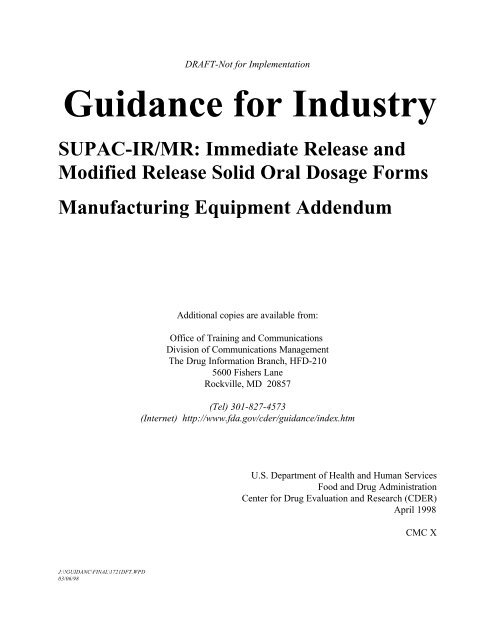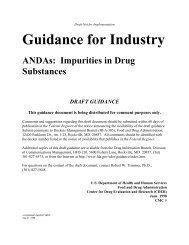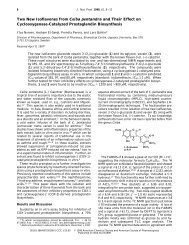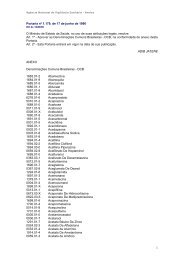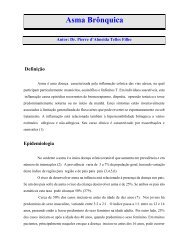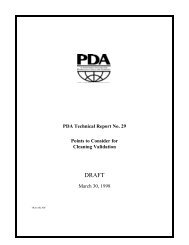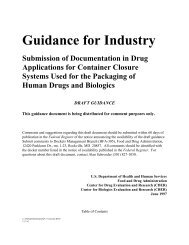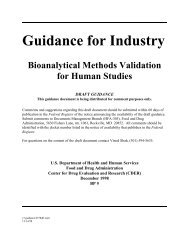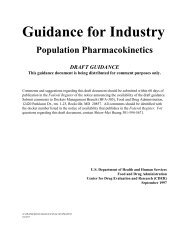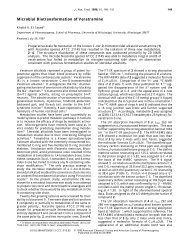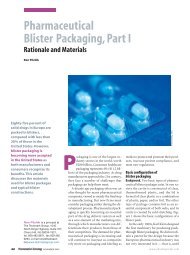MR/IR equipment addendum - Pharmanet
MR/IR equipment addendum - Pharmanet
MR/IR equipment addendum - Pharmanet
You also want an ePaper? Increase the reach of your titles
YUMPU automatically turns print PDFs into web optimized ePapers that Google loves.
DRAFT-Not for ImplementationGuidance for IndustrySUPAC-<strong>IR</strong>/<strong>MR</strong>: Immediate Release andModified Release Solid Oral Dosage FormsManufacturing Equipment AddendumAdditional copies are available from:Office of Training and CommunicationsDivision of Communications ManagementThe Drug Information Branch, HFD-2105600 Fishers LaneRockville, MD 20857(Tel) 301-827-4573(Internet) http://www.fda.gov/cder/guidance/index.htmU.S. Department of Health and Human ServicesFood and Drug AdministrationCenter for Drug Evaluation and Research (CDER)April 1998CMC XJ:\!GUIDANC\FINAL\1721DFT.WPD03/06/98
DRAFT-Not for ImplementationTABLE OF CONTENTSI. INTRODUCTION ....................................................1II. PARTICLE SIZE REDUCTION/SEPARATION ...........................3III. BLENDING AND MIXING ............................................9IV. GRANULATION ....................................................14V. DRYING ..........................................................20VI. UNIT DOSING .....................................................26VII. SOFT GELATIN CAPSULES .........................................29VIII. COATING/PRINTING/DRILLING .....................................37J:\!GUIDANC\FINAL\1721DFT.WPD03/06/98 i
DRAFT-Not for ImplementationGUIDANCE FOR INDUSTRY 1SUPAC-<strong>IR</strong>/<strong>MR</strong>: Immediate Release and Modified Release Solid Oral DosageForms Manufacturing Equipment AddendumI. INTRODUCTIONThe purpose of this guidance is to provide recommendations to pharmaceutical manufacturersusing the Center for Drug Evaluation and Research's Guidance for Industry: Immediate ReleaseSolid Oral Dosage Forms — Scale-Up and Post-Approval Changes: Chemistry, Manufacturingand Controls, In Vitro Dissolution Testing, and In Vivo Bioequivalence Documentation(SUPAC-<strong>IR</strong>), which published in November 1995, and Guidance for Industry: SUPAC-<strong>MR</strong>:Modified Release Solid Oral Dosage Forms Scale-Up and Post-Approval Changes: Chemistry,Manufacturing and Controls; In Vitro Dissolution Testing and In Vivo BioequivalenceDocumentation, which published in October 1997. This document was developed by the U.S.Food and Drug Administration (FDA) with the assistance of the International Society ofPharmaceutical Engineering (ISPE). This document extends and supercedes the ManufacturingEquipment Addendum published in October 1997 that covered only immediate release solid oraldosage forms.The document should be used in conjunction with the SUPAC-<strong>IR</strong> and SUPAC-<strong>MR</strong> guidancedocuments in determining what documentation should be submitted to FDA regarding <strong>equipment</strong>changes made in accordance with the recommendations in sections V and VI.A of the SUPAC-<strong>IR</strong>guidance document and in sections VI and VII of the SUPAC-<strong>MR</strong> guidance document. TheSUPAC guidance documents define (1) levels of change; (2) recommended chemistry,manufacturing, and controls tests for each level of change; (3) in vitro dissolution tests and/or invivo bioequivalence tests for each level of change; and (4) documentation that should support thechange for new drug applications (NDAs) and abbreviated new drug applications (ANDAs).This document is only an aid and, in some cases, specific <strong>equipment</strong> may not be listed. It does,however, include a representative list of <strong>equipment</strong> commonly used in the industry. The guidancedoes not address <strong>equipment</strong> that has been modified by a pharmaceutical manufacturer to fit its1This guidance has been prepared under the auspices of the Chemistry, Manufacturing, and ControlsCoordinating Committee in the Center for Drug Evaluation and Research (CDER) and the Office of Regulatory Affairs(ORA) at the Food and Drug Administration with the assistance of the International Society of PharmaceuticalEngineering (ISPE). This guidance represents the Agency's current thinking on <strong>equipment</strong> changes under SUPAC-<strong>IR</strong>and SUPAC-<strong>MR</strong>. It does not create or confer any rights for or on any person and does not operate to bind the FDA orthe public. An alternative approach may be used if such approach satisfies the requirements of the applicable statute,regulations or both.J:\!GUIDANC\FINAL\1721DFT.WPD03/06/98
DRAFT-Not for Implementationspecific needs. If questions arise in using this guidance document please contact the appropriatereviewing office at CDER.Although this guidance does not discuss validation, any <strong>equipment</strong> changes should be validated inaccordance with current good manufacturing practices (cGMPs) and the resulting data will besubject to examination by field investigators during routine GMP inspections. The information ispresented in broad categories of unit operation (blending and mixing, drying, particle sizereduction/separation, granulation, unit dosage, coating and printing, soft gelatin capsuleencapsulation). Definitions and classification are provided. For each operation, a table ispresented that categorizes <strong>equipment</strong> by class (operating principle) and subclass (designcharacteristic). Examples are given within the subclasses.Equipment within the same class and subclass would be considered to have the same design andoperating principle under SUPAC-<strong>IR</strong> and SUPAC-<strong>MR</strong>. Therefore, for example, a change fromone type of diffusion mixer (e.g, V-blender from manufacturer A) to another diffusion mixer (e.g.,V-blender from manufacturer B) generally would not represent a change in operating principleand would, therefore, be considered to be the same under either SUPAC-<strong>IR</strong> or SUPAC-<strong>MR</strong>.A change from <strong>equipment</strong> in one class to <strong>equipment</strong> in a different class would usually beconsidered a change in design and operating principle. For example, a change from a V-blenderto a ribbon blender demonstrates a change in the operating principle from diffusion blending toconvection blending and would be considered to be different under either SUPAC-<strong>IR</strong> or SUPAC-<strong>MR</strong>.For modified release dosage forms, a change in <strong>equipment</strong> within the same class but to a differentsubclass would usually be considered a change in <strong>equipment</strong> to a different design and operatingprinciples under SUPAC-<strong>MR</strong> if it involves a unit operation critical to drug release.Applicants should carefully consider and evaluate on a case-by-case basis changes in <strong>equipment</strong>that are in the same class, but different subclass. In many situations, this type of change in<strong>equipment</strong> would be considered similar, provided the unit operation is not critical to drug releasefor a modified release dosage form. For example, within the Blending and Mixing section, underthe Diffusion Mixers Class, a change from a V-blender (sub-class) to a Bin tumbler (sub-class)represents a change within a class and between sub-classes. Provided the manufacturing processwith the new <strong>equipment</strong> is validated and that this operation is not critical to drug release for amodified release dosage form, this change would likely not need a pre-approval supplement. Theapplicant should have available at the time of the change the scientific data and rationale used tomake this determination. This information is subject to FDA review at its discretion. It is up tothe applicant to determine the filing requirement.This guidance will be updated as needed to reflect the introduction and discontinuation of specificJ:\!GUIDANC\FINAL\1721DFT.WPD03/06/98 2
DRAFT-Not for Implementationtypes of manufacturing <strong>equipment</strong>. Manufacturers of <strong>equipment</strong> are encouraged to help keep thedocument current by communicating changes to the Agency and by making suggestions regardingwhat <strong>equipment</strong> should be considered to be within the same class or subclass. The submittedinformation will be reviewed by FDA and incorporated in an updated guidance document asappropriate.II.PARTICLE SIZE REDUCTION/SEPARATIONA. Definitions1. Unit Operationsa. Particle Size Reduction: The mechanical process of breakingparticles into smaller pieces via one or more particle size reductionmechanisms. The mechanical process used generally is referred toas milling.i. Particle - Refers to either a discrete crystal or a grouping ofcrystals, generally known as an agglomerate.ii.Particle Size Reduction MechanismsCCCCImpact - Particle size reduction by applying aninstantaneous force perpendicular to theparticle/agglomerate surface. The force can resultfrom particle-to-particle or particle-to-mill surfacecollision.Attrition - Particle size reduction by applying aforce in a direction parallel to the particle surface.Compression - Particle size reduction by applying aforce slowly (as compared to Impact) to the particlesurface in a direction toward the center of theparticle.Cutting - Particle size reduction by applying ashearing force to a material.b. Particle Separation: Particle size classification according toJ:\!GUIDANC\FINAL\1721DFT.WPD03/06/98 3
DRAFT-Not for Implementationparticle size alone.2. Operating Principlesa. Fluid Energy MillingParticles are reduced in size as a result of high-speed particle-toparticleimpact and/or attrition; also known as micronizing.b. Impact MillingParticles are reduced in size by high-speed mechanical impact orimpact with other particles; also known as milling, pulverizing, orcomminuting.c. CuttingParticles are reduced in size by mechanical shearing.d. Compression MillingParticles are reduced in sized by compression stress and shearbetween two surfaces.e. ScreeningParticles are reduced in size by mechanically induced attritionthrough a screen. This process commonly is referred to as millingor deagglomeration.f. Tumble MillingParticles are reduced in size by attrition utilizing grinding media.g. SeparatingB. Equipment ClassificationsParticles are segregated based upon particle size alone and withoutany significant particle size reduction. This process commonly isreferred to as screening or bolting.J:\!GUIDANC\FINAL\1721DFT.WPD03/06/98 4
1. Fluid Energy MillsDRAFT-Not for ImplementationFluid energy mill subclasses have no moving parts and primarily aredistinguished from one another by the configuration and/or shape of theirchambers, nozzles, and classifiers.CCCCCCCTangential JetLoop/OvalOpposed JetOpposed Jet with Dynamic ClassifierFluidized BedFixed TargetMoving Target2. Impact MillsImpact mill subclasses primarily are distinguished from one another by theconfiguration of the grinding heads, chamber grinding liners (if any), andclassifiers.CCCCHammer Air SweptHammer ConventionalPin/DiscCage3. Cutting MillsAlthough cutting mills may differ from one another in whether the knivesare movable or fixed and in the classifier configuration, no cutting millsubclasses have been identified.4. Compression MillsAlthough compression mills may differ from one another in whether one orboth surfaces are moving, no compression mill subclasses have beenidentified.5. Screening MillsScreening mill subclasses primarily are distinguished from one another bythe rotating element.J:\!GUIDANC\FINAL\1721DFT.WPD03/06/98 5
DRAFT-Not for ImplementationCCCRotating ImpellerRotating ScreenOscillating Bar6. Tumbling MillsTumbling mill subclasses primarily are distinguished from one another bythe grinding media used and by whether the mill is vibrated.CCCBall MediaRod MediaVibrating7. SeparatorsSeparator subclasses primarily are distinguished from one another by themechanical means used to induce particle movement.CCVibratory/ShakerCentrifugalJ:\!GUIDANC\FINAL\1721DFT.WPD03/06/98 6
DRAFT-Not for ImplementationTable 1Unit Operation - Particle Size ReductionClass Subclass ExamplesFluid Energy Mills Tangential Jet Alpine (Hosokawa)Fluid Energy AljetSturtevantLoop/OvalOpposed JetOpposed Jet with Dynamic ClassifierFluidized BedFixed TargetMoving TargetFluid Energy AljetGarlockAlpine (Hosokawa)Fluid Energy AljetNone IdentifiedNone IdentifiedNone IdentifiedImpact Mills Hammer Air Swept Alpine (Hosokawa)Bepex (Hosokawa)SturtevantHammer ConventionalPin/DiscCageAlpine (Hosokawa)FitzpatrickFluid AirMikro (Hosokawa)Rietz (Hosokawa)Stokes-MerrillAlpine (Hosokawa)KemutecSturtevantStedmanCutting Mills None Identified Alpine (Hosokawa)FitzpatrickUrschelCompression Mills None Identified MCA InternationalJ:\!GUIDANC\FINAL\1721DFT.WPD03/06/98 7
DRAFT-Not for ImplementationTable 1Unit Operation - Particle Size Reduction (cont.)Class Subclass ExamplesScreening Mills Rotating Impeller Bepex (Hosokawa)FitzpatrickFluid AirKemutecQuadroStokes-MerrillZanchetta (Romaco)Rotating ScreenOscillating BarGlattBepex (Hosokawa)FrewittJackson-CrockattStokes-MerrillVectorTumbling Mills Ball Media US StonewareRod MediaVibratingNone IdentifiedSwecoTable 2Unit Operation - SeparationClass Subclass ExamplesSeparators Vibratory/Shaker AllgaierMcLanahanRotexRussell FinexSwecoVortiSivCentrifugalAZOKasonKemutecSwecoJ:\!GUIDANC\FINAL\1721DFT.WPD03/06/98 8
DRAFT-Not for ImplementationIII.BLENDING AND MIXINGA. Definitions1. Unit OperationsBlending and Mixing: The reorientation of particles relative to oneanother in order to achieve uniformity.2. Operating Principlesa. Diffusion Blending (Tumble)Particles are reoriented in relation to one another when they areplaced in random motion and interparticular friction is reduced asthe result of bed expansion (usually within a rotating container);also known as tumble blending.b. Convection MixingParticles are reoriented in relation to one another as a result ofmechanical movement; also known as paddle or plow mixing.c. Pneumatic MixingB. Equipment ClassificationsParticles are reoriented in relation to one another as a result of theexpansion of a powder bed by gas.1. Diffusion Mixers (Tumble)Diffusion mixer subclasses primarily are distinguished by geometric shapeand the positioning of the axis of rotation.CCCCCCV-blendersDouble Cone BlendersSlant Cone BlendersCube BlendersBin BlendersHorizontal/Vertical/Drum BlendersJ:\!GUIDANC\FINAL\1721DFT.WPD03/06/98 9
DRAFT-Not for ImplementationTable 1Unit Operation - Blending and MixingClass Subclass ExamplesDiffusion Mixers V-Blenders Aaron(Tumble)Paul O. AbbeGemcoJaygoKemutecLlealLoweO’HaraPatterson-KelleyPneuvacZanchetta (Romaco)Double Cone BlendersSlant Cone BlendersCube BlendersAaronPaul O. AbbeGemcoJaygoKemutecLlealLoweMO IndustriesPatterson- KelleyPneuvacServoLiftZanchetta (Romaco)GemcoLlealPatterson-KelleyLightninServoLiftZanchetta (Romaco)J:\!GUIDANC\FINAL\1721DFT.WPD03/06/98 11
DRAFT-Not for ImplementationTable 1Unit Operation - Blending & Mixing (cont.)Class Subclass ExamplesDiffusion Mixers (Tumble) Bin Blenders Paul O. Abbe(cont.)L. B. BohleCora InternationalCONSEPCreative Design & MachineCustom Metal CraftGEI-Gallay (GEI North America/Patriot)GemcoGlattJenike & JohansonKemutecMatcon, USAScholl (MO Industries)ServoLiftTote SystemsZanchetta (Romaco)Horizontal/Vertical/Drum BlendersStatic Continuous BlendersDynamic Continuous BlendersMunson Mill MachineryRossPatterson-KelleyConvection Mixers Ribbon Blenders AaronPaul O. AbbeAutomatic Industry MachinesAzo-RubergCustom Metal CraftJaygoKemutecLowePneuvacRossVrieco-Nauta (Hosokawa)Orbiting Screw BlendersAaronJaygoLittleford DayRossVrieco-Nauta (Hosokawa)J:\!GUIDANC\FINAL\1721DFT.WPD03/06/98 12
DRAFT-Not for ImplementationTable 1Unit Operation - Blending & Mixing (cont.)Class Subclass ExamplesConvection Mixers (cont.) Planetary Blenders AaronAeschbachAMFGEI-Collette (GEI North America/Vector)HobartJaygoLittleford DayRossVriecoForberg BlendersHorizontal Double Arm BlendersHorizontal High Intensity MixersVertical High Intensity MixersDiffusion Mixers (Tumble) withIntensifier/AgitatorPaul O. AbbeDynamic AirAaronPaul O. AbbeCustom Metal CraftDynamic AirJaygoKemutecLittleford DayRossSigmaTeledyne ReadcoLittleford DayAeromatic-Fielder (GEA-Niro)APVL.B. BohleDierks & ShoneGEI-Collette (GEI North America/Vector)Key InternationalLittleford DayPowrex (Glatt)Zanchetta (Romaco)Paul O. AbbeGemcoPatterson-KelleyPneumatic Mixers None Identified Dynamic AirReimeltJ:\!GUIDANC\FINAL\1721DFT.WPD03/06/98 13
DRAFT-Not for ImplementationIV.GRANULATIONA. Definitions1. Unit OperationsGranulation: The process of creating granules. The powder morphologyis modified through the use of either a liquid that causes particles to bindthrough capillary forces or dry compaction forces. The process will resultin one or more of the following powder properties: enhanced flow;increased compressibility; densification; alteration of physical appearanceto more spherical, uniform, or larger particles; and/or enhancedhydrophilic surface properties.2. Operating Principlesa. Dry GranulationDry powder densification and/or agglomeration by direct physicalcompaction.b. Wet High-Shear GranulationPowder densification and/or agglomeration by the incorporation ofa granulation fluid into the powder with high-power-per-unit mass,through rotating high-shear forces.c. Wet Low-Shear GranulationPowder densification and/or agglomeration by the incorporation ofa granulation fluid into the powder with low-power-per-unit mass,through rotating low-shear forces.d. Low-Shear Tumble GranulationPowder densification and/or agglomeration by the incorporation ofa granulation fluid into the powder with low-power-per-unit mass,through rotation of the container vessel and/or intensifier bar.e. Extrusion GranulationJ:\!GUIDANC\FINAL\1721DFT.WPD03/06/98 14
DRAFT-Not for ImplementationPlasticization of solids or wetted mass of solids and granulationfluid with linear shear through a sized orifice using a pressuregradient.f. Rotary GranulationSpheronization, agglomeration, and/or densification of a wetted ornon-wetted powder or extruded material. This is accomplished bycentrifugal or rotational forces from a central rotating disk,rotating walls, or both. The process may include the incorporationand/or drying of a granulation fluid.g. Fluid Bed GranulationPowder densification and/or agglomeration with little or no shearby direct granulation fluid atomization and impingement on solids,while suspended by a controlled gas stream, with simultaneousdrying.h. Spray Dry GranulationB. Equipment Classification1. Dry GranulatorA pumpable granulating liquid containing solids (in solution orsuspension) is atomized in a drying chamber and rapidly dried by acontrolled gas stream, producing a dry powder.Dry granulator subclasses primarily are distinguished by the densificationforce application mechanism.CCSluggingRoller Compaction2. Wet High-Shear GranulatorWet high-shear granulator subclasses primarily are distinguished by thegeometric positioning of the primary impellers; impellers can be top,bottom, or side driven.J:\!GUIDANC\FINAL\1721DFT.WPD03/06/98 15
DRAFT-Not for ImplementationCCTop or Bottom DrivenSide Driven3. Wet Low-Shear GranulatorWet low-shear granulator subclasses primarily are distinguished by thegeometry and design of the shear inducing components; shear can beinduced by rotating impeller, reciprocal kneading action, or convectionscrew action.CCCPlanetaryKneadingScrew4. Low-Shear Tumble GranulatorAlthough low-shear tumble granulators may differ from one another invessel geometry and type of dispersion or intensifier bar, no low-sheartumble granulator subclasses have been identified.5. Extrusion GranulatorExtrusion granulator subclasses primarily are distinguished by theorientation of extrusion surfaces and driving pressure productionmechanism.CCCCRadial or BasketAxialRamRoller, Gear, or Pelletizer6. Rotary GranulatorRotary granulator subclasses primarily are distinguished by their structuralarchitecture. They have either open top architecture, such as a verticalcentrifugal spheronizer, or closed top architecture, such as a closed topfluid bed dryer.CCOpenClosedJ:\!GUIDANC\FINAL\1721DFT.WPD03/06/98 16
7. Fluid Bed GranulatorDRAFT-Not for ImplementationAlthough fluid bed granulators may differ from one another in geometry,operating pressures, and other conditions, no fluid bed granulatorsubclasses have been identified.8. Spray Dry GranulatorAlthough spray dry granulators may differ from one another in geometry,operating pressures, and other conditions, no spray dry granulatorsubclasses have been identified.Note:If a single piece of <strong>equipment</strong> is capable of performing multiple discrete unit operations (mixing,granulating, drying), the unit was evaluated solely for its ability to granulate. If multifunctionalunits were incapable of discrete steps (fluid bed granulator/drier), the unit was evaluated as anintegrated unit.J:\!GUIDANC\FINAL\1721DFT.WPD03/06/98 17
DRAFT-Not for ImplementationTable 1Unit Operation - GranulationClass Subclass ExamplesDry Granulator Slugging VariousRoller CompactionAlexanderwerkBepex (Hosokawa)FitzpatrickFreundVectorWet High Shear Granulator Top Driven, or Bottom Driven Aeromatic-Fielder (GEA-Niro)Baker-PerkinsL.B. BohleDiosnaGEI-Collette (GEI North America/Vector)KeyLittleford DayPowrex (Glatt)Werner & PfeidererZanchetta (Romaco)Side DrivenLodigeWet Low Shear Granulator Planetary AaronAeschbachAMFGEI-Collette (GEI North America/Vector)HobartJaygoLittleford DayRossVriecoKneadingScrewAaronPaul O. AbbeCustom Metal CraftDynamic AirJaygoKemutecLittleford DayRossSigmaTeledyne ReadcoVrieco-Nauta (Hosokawa)Low Shear Tumble Granulator Slant Cone, or Double Cone, or V- Paul O. AbbeBlenderGemcoPatterson-KelleyJ:\!GUIDANC\FINAL\1721DFT.WPD03/06/98 18
DRAFT-Not for ImplementationTable 1Unit Operation - Granulation (cont.)Class Subclass ExamplesExtrusion Granulator Radial or Basket AlexanderwerkGEA NiroLCILuwaRossAxialRamRoller, Gear, or PelletizerBepex (Hosokawa)GablerLCILCIAlexanderwerkBepex (Hosokawa)Rotary Granulator Open Freund (Vector)GEA NiroLCILuwaClosedAeromatic-Fielder (GEA Niro)GlattLCIVectorFluid Bed Granulator None Identified Aeromatic-Fielder (GEA Niro)APVBWI Hüttlin (Thomas Engineering)DiosnaFitzpatrickFluid AirGlattHeinenVectorSpray Dry Granulator None Identified AllgaierGEA NiroGlattHeinenJ:\!GUIDANC\FINAL\1721DFT.WPD03/06/98 19
DRAFT-Not for ImplementationV. DRYINGA. Definitions1. Unit OperationDrying: The removal of a liquid from a solid by evaporation.2. Operating Principlesa. Direct Heating, Static Solids BedHeat transfer is accomplished by direct contact between the wetsolids and hot gases. The vaporized liquid is carried away by thedrying gases. There is no relative motion among solid particles.The solids bed exists as a dense bed, with the particles resting uponone another.b. Direct Heating, Moving Solids BedHeat transfer is accomplished by direct contact between the wetsolids and hot gases. The vaporized liquid is carried away by thedrying gases. Solids motion is achieved by either mechanicalagitation or gravity force, which slightly expands the bed enoughto flow one particle over another.c. Direct Heating, Fluidized Solids BedHeat transfer is accomplished by direct contact between the wetsolids and hot gases. The vaporized liquid is carried away by thedrying gases. The solids are in an expanded condition, with theparticles supported by drag forces caused by the gas phase. Thesolids and gases intermix and behave like a boiling liquid. Thisprocess commonly is referred to as fluid bed drying.d. Direct Heating, Dilute Solids Bed, Spray DryingHeat transfer is accomplished by direct contact between a highlydispersed liquid and hot gases. The feed liquid may be a solution,slurry, emulsion, gel or paste, provided it is pumpable and capableof being atomized. The fluid is dispersed as fine droplets into aJ:\!GUIDANC\FINAL\1721DFT.WPD03/06/98 20
DRAFT-Not for Implementationmoving stream of hot gases, where they evaporate rapidly beforereaching the wall of the drying chamber. The vaporized liquid iscarried away by the drying gases. The solids are fully expandedand so widely separated that they exert essentially no influence onone another.e. Direct Heating, Dilute Solids Bed, Flash DryingHeat transfer is accomplished by direct contact between wet solidsand hot gases. The solid mass is suspended in a finely divided statein a high-velocity and high-temperature gas stream. The vaporizedliquid is carried away by the drying gases.f. Indirect Conduction, Moving Solids BedHeat transfer to the wet solid is through a retaining wall. Thevaporized liquid is removed independently from the heatingmedium. Solids motion is achieved by either mechanical agitationor gravity force, which slightly expands the bed enough to flowone particle over another.g. Indirect Conduction, Static Solids BedHeat transfer to the wet solid is through a retaining wall. Thevaporized liquid is removed independently from the heatingmedium. There is no relative motion among solid particles. Thesolids bed exists as a dense bed, with the particles resting upon oneanother.h. Indirect Conduction, LyophilizationDrying in which the water vapor sublimes from the product afterfreezing.i. Gas StrippingHeat transfer is a combination of direct and indirect heating. Thesolids motion is achieved by agitation and the bed is partiallyfluidized.j. Indirect Radiant, Moving Solids BedJ:\!GUIDANC\FINAL\1721DFT.WPD03/06/98 21
B. Equipment ClassificationsDRAFT-Not for ImplementationHeat transfer is accomplished with varying wavelengths of energy.Vaporized liquid is removed independently from the solids bed.The solids motion is achieved by mechanical agitation, whichslightly expands the bed enough to flow one particle over oneanother. This process commonly is referred to as microwavedrying.1. Direct Heating, Static Solids BedStatic solids bed subclasses primarily are distinguished by the method ofmoving the solids into the dryer.CCTray and TruckBelt2. Direct Heating, Moving Solids BedMoving solids bed subclasses primarily are distinguished by the method ortechnology for moving the solids bed.CCRotating TrayHorizontal Vibrating Conveyor3. Direct Heating, Fluidized Solids Bed (Fluid Bed Dryer)Although fluid bed dryers may differ from one another in geometry,operating pressures, and other conditions, no fluidized solids bed dryersubclasses have been identified.4. Direct Heating, Dilute Solids Bed, Spray DryerAlthough spray dryers may differ from one another in geometry, operatingpressures, and other conditions, no spray dryer subclasses have beenidentified.5. Direct Heating, Dilute Solids Bed, Flash DryerAlthough flash dryers may differ from one another in geometry, operatingpressures, and other conditions, no flash dryer subclasses have beenJ:\!GUIDANC\FINAL\1721DFT.WPD03/06/98 22
identified.DRAFT-Not for Implementation6. Indirect Conduction Heating, Moving Solids BedMoving solids bed subclasses primarily are distinguished by the method ortechnology for moving the solids bed.CCCPaddleRotary (Tumble)Agitation7. Indirect Conduction Heating, Static Solids BedsNo indirect heating, static solids bed shelf dryer subclasses have beenidentified.8. Indirect Conduction, LyophilizationNo lyophilizer subclasses have been identified.9. Gas StrippingAlthough gas stripping dryers may differ from one another in geometry,shape of agitator, and how fluidizing gas is moved through the bed, no gasstripping dryer subclasses have been identified.10. Indirect Radiant Heating, Moving Solids Bed (Microwave Dryer)Although microwave dryers may differ from one another in vesselgeometry and the way microwaves are directed into the solids, no indirectradiant heating, moving solids bed dryer subclasses have been identified.Note:If a single piece of <strong>equipment</strong> is capable of performing multiple discrete unit operations (mixing,granulating, drying), the unit was evaluated solely for its ability to dry. The drying <strong>equipment</strong>was sorted into similar classes of <strong>equipment</strong>, based upon the method of heat transfer and thedynamics of the solids bed.J:\!GUIDANC\FINAL\1721DFT.WPD03/06/98 23
DRAFT-Not for ImplementationTable 1Unit Operation - DryingClass Subclass ExamplesDirect Heating, Static Solids Bed Tray and Truck ColtonDespatchGruenbergHot PackLydonO’HaraProctor & SchwartzTrentBeltDespatchProctor & SchwartzDirect Heating, Moving Solids Bed Rotating Tray Krauss MaffeiWyssmontHorizontal Vibrating ConveyorCarrierWitteDirect Heating, Fluidized Solids Bed None Identified Aeromatic-Fielder (GEA-Niro)(Fluid Bed Dryer)APVBWI Hüttlin (Thomas Engineering)DiosnaFitzpatrickFluid AirGlattHeinenVectorDirect Heating, Dilute Solids Bed, None Identified AllgaierSpray DryerAPVBWI Hüttlin (Thomas Engineering)GEA-NiroGlattDirect Heating, Dilute Solids Bed, None Identified AllgaierFlash DryerAPVGEA-NiroMicron (Hosokawa)J:\!GUIDANC\FINAL\1721DFT.WPD03/06/98 24
DRAFT-Not for ImplementationTable 1Unit Operation - Drying (cont.)Class Subclass ExamplesIndirect Conduction, Moving Solids Paddle Bepex (Hosokawa)BedJaygoRotary (Tumble)AgitationPaul O. AbbeGemcoGlattLittleford DayPatterson-KelleyZanchetta (Romaco)L. B. BohleDiosnaGEI-Collette (GEI North America)Krauss MaffeiVrieco-Nauta (Hosokawa)Zanchetta (Romaco)Indirect Conduction, Static Solids None Identified HullBedIndirect Conduction, Lyophilization None Identified AmscoHullSerailStokesGas Stripping None Identified Aeromatic-Fielder (GEA-Niro)L.B. BohleDiosnaGEI-Collette (GEI North America)Zanchetta (Romaco)Indirect Radiant Heating, Moving None Identified Aeromatic-Fielder (GEA-Niro)Solids Bed (Microwave Dryer)L. B. BohleDiosnaGEI-Collette (GEI North America)J:\!GUIDANC\FINAL\1721DFT.WPD03/06/98 25
DRAFT-Not for ImplementationCCCCGravityPower AssistedCentrifugalCompression Coating2. EncapsulatorEncapsulator subclasses primarily are distinguished from one another bythe method that is used for forming the powder blend into the slug.Encapsulators can deliver powders with a rotating auger, vacuum,vibration of perforated plate, tamping into a bored disk (dosing disk), orcylindrical tubes fitted with pistons (dosator).CCCCCAugerVacuumVibratoryDosing DiskDosator3. Powder FillerSubclasses of powder fillers primarily are distinguished by the method usedto deliver the predetermined amount for container fill.CCVacuumAugerJ:\!GUIDANC\FINAL\1721DFT.WPD03/06/98 27
DRAFT-Not for ImplementationTable 1Unit DosingClass Subclass ExamplesTablet Press Gravity Colton (Vector)Manesty (Thomas Engineering)StokesPower AssistedCentrifugalCompression CoatingColton (Vector)Courtoy (AC Compacting)FetteHata (Elizabeth Carbide)KikusuiKilianManesty (Thomas Engineering)Comprima (IMA)Manesty (Thomas Engineering)KikusuiKilianEncapsulator Auger Capsugel Type BElanco No. 8VacuumVibratoryDosing DiskDosatorPerryOsaka (Sharpley-Stokes)H&K/ BoschIndexMacofar (Romaco)MG2Zanasi/Pharmatic/IMAPowder Filler Vacuum BoschPerryZanasiAugerAll-FillCalumaticJ:\!GUIDANC\FINAL\1721DFT.WPD03/06/98 28
DRAFT-Not for ImplementationVII.SOFT GELATIN CAPSULESA. Definitions1. Unit Operationsa. Gel Mass Preparation: The manufacture of ahomogeneous, degassed liquid mass (solution) ofgelatin, plasticizer, water, and other additives, either insolution or suspension, such as colorants, pigments,flavors, preservatives, etc., that comprise a uniquefunctional gel shell formation. The operation may beperformed in discreet steps or by continuousprocessing. Minor components can be added after theliquid gel mass is made.b. Fill Mixing: The mixing of either liquids or solids with otherliquids to form a solution; blending of limited solubility solid(s)with a liquid carrier and suspending agents used to stabilize theblend to form a suspension; or the uniform combination of dry inertand drug active substances to form a dry powder fill suitable forencapsulation. The reader should refer to the other sections of thisdocument for dry fill manufacture.c. Core Enrobing: The gelatin coating of gravity or force fed preformedtablets or caplets.d. Encapsulation: The continuous casting of gel ribbons, with liquidfill material being injected between the gel ribbons using a positivedisplacement pump or, for dry materials being gravity or force fedwith capsule formation using a rotary die.e. Washing: The continuous removal of a lubricant material from theoutside of the formed capsule. The washing operation is unique toeach manufacturer's operation and generally uses in-housefabricated <strong>equipment</strong>. This <strong>equipment</strong> will not be discussed in thisguidance document.f. Drying: The removal of the majority of water from the capsule'sgel shell by tumbling and subsequent tray drying using conditionedair, which enhances the size, shape, and shell physical properties ofJ:\!GUIDANC\FINAL\1721DFT.WPD03/06/98 29
DRAFT-Not for Implementationthe final product. The drying operation is unique to eachmanufacturer's operation and generally uses in-house fabricated<strong>equipment</strong>. This <strong>equipment</strong> will not be discussed in this guidancedocument.g. Inspection/Sorting: The process wherein undesirable capsules areremoved, including misshapen, leaking, and unfilled capsules aswell as agglomerates of capsules.h. Printing: The marking of a capsule surface for the purpose ofproduct identification, using a suitable printing media or method.2. Operating Principlesa. MixingThe combination of solid and liquid components, includingsuspending aid(s) at either ambient or elevated temperatures toform a solution, suspension, or dry powder blend for themanufacture of gel mass or fill material. Mixing also includes theincorporation of minor components into the liquid gel mass.b. DeaggregationThe removal of aggregates using a suitable homogenizer/mill toprovide a pumpable fill material. The procedure has minimal effecton the particle size distribution of the initial solid component(s),and is viewed as a processing aid. 2c. DeaerationThe removal of entrapped air from either the gel mass or fillmaterial, solution or suspension. This process can take place ineither the mixing vessel, through the application of vacuum, or aseparate off-line step.d. HoldingThe storage of liquid gel mass or fill material in a vessel, with a2Carstensen, J. T., “Theory of Pharmaceutical Systems, Volume 11 Heterogeneous Systems," Academic Press,New York, NY, 1973, p 51.J:\!GUIDANC\FINAL\1721DFT.WPD03/06/98 30
DRAFT-Not for Implementationmixer or without, prior to encapsulation, which also may beequipped with a jacket for either heating or cooling.e. EncapsulationThe formation of capsules using a rotary die machine. 3f. Inspection/SortingThe physical removal of misshapen, leaking, or agglomeratedcapsules, using either a manual or automatic operation.g. PrintingB. Equipment ClassificationsThe user of this document is asked to refer to the coating/printingsection, in which the use of various pieces of <strong>equipment</strong> aredefined and categorized.1. Mixers and Mixing VesselsMixer and mixing vessel subclasses primarily are distinguished by themixing energy, mixer type, and whether a jacketed vessel with vacuumcapabilities is used in conjunction with a specific mixer.CCCCCLow Energy MixerHigh Energy MixerPlanetaryJacketed Vessel With and Without VacuumConventional2. Deaggregators3Lachman, L., H. A. Lieberman, and J. L. Kanig (Eds.), The Theory and Practice of Industrial Pharmacy,Chapter 3, p. 359 (Stanley, J. P.), Philadelphia: Lea & Febiger, 1971.Tyle, P. (Ed.), Specialized Drug Delivery Systems, Manufacturing and Production Technology, Chapter 10, p. 409(Wilkinson, P.K.and F.S. Hom), New York: M. Dekker, 1990.Porter, S., Remington’s Pharmaceutical Sciences, Edition 18, Chapter 89, pp. 1662 - 1665, Easton, Penn.: MackPublishing Co.J:\!GUIDANC\FINAL\1721DFT.WPD03/06/98 31
DRAFT-Not for ImplementationDeaggregator subclasses primarily are distinguished by the type ofmechanical action imparted to the material.CCCCCRotor/StatorRollerCutting MillsStone MillsTumbling Mills3. DeaeratorsDeaerator subclasses primarily are distinguished by the air removal path,either through the bulk or through a thin film, and whether it is a batch orin-line process.CCVacuum VesselOff Line/In Line4. Holding VesselsAlthough holding vessels may differ from one another, based uponwhether they are jacketed, with and without integrated mixing capabilities,no holding vessel subclasses have beeen identified.5. EncapsulatorsEncapsulator subclasses primarily are distinguished by the method used toinject the fill material.CCPositive Displacement PumpGravity or Force Fed6. Inspection/SortingInspection/sorting <strong>equipment</strong> subclasses primarily are distinguished by themethod used to present the capsule for viewing and mechanical method ofseparation.CCCBeltVibratoryRollerJ:\!GUIDANC\FINAL\1721DFT.WPD03/06/98 32
DRAFT-Not for ImplementationCCRotary TableElectromechanicalJ:\!GUIDANC\FINAL\1721DFT.WPD03/06/98 33
DRAFT-Not for ImplementationTable 1Unit Operation - Soft Gelatin CapsulesClass Subclass ExamplesMixers and Mixing Vessels Low Energy GEI-Collette (GEI North America/Vector)GEI-Kreiger (GEI North America)HobartKoruma (Romaco)LightninMoorhouse-CowlesQuadroHigh EnergyPlanetaryJacketed with and without VacuumConventionalCowlesGEI-Collette (GEI North America/Vector)Koruma (Romaco)AaronAeschbachAMFGEI-Collette (GEI North America/Vector)HobartJaygoLittleford DayRossVriecoBecomixFrymaGEI-Kreiger (GEI North America)HicksLee IndustriesPaul Mueller Co.RossKoruma (Romaco)Lee IndustriesJ:\!GUIDANC\FINAL\1721DFT.WPD03/06/98 34
DRAFT-Not for ImplementationTable 1Unit Operation - Soft Gelatin Capsules (cont.)Class Subclass ExamplesDeaggregators Rotor Stator BarincoGreercoKoruma (Romaco)RollerCutting MillsStone MillsTumbling MillsStokes-MerrillAlpine(Hosokawa)FitzpatrickUrschelFrymaKoruma (Romaco)Paul O. AbbeFrymaPremier Corp.U.S. StonewareDeaerators Vacuum Vessel FrymaGEI-Kreiger (GEI North America)Koruma (Romaco)Lee IndustriesPaul Mueller Co.Off Line/In LineThe Cornell Machine Co.FrymaKoruma (Romaco)Holding Vessels Jacketed Vessel with and without GEI-Kreiger (GEI North America)Mixing SystemKoruma (Romaco)Lee IndustriesJ:\!GUIDANC\FINAL\1721DFT.WPD03/06/98 35
DRAFT-Not for ImplementationTable 1Unit Operation - Soft Gelatin Capsules (cont.)Class Subclass ExamplesEncapsulators Positive Displacement Pump Chang SungGaberino International ConsultantsHiguchi, Inc. USAHypak IndustriesIn House ConstructionJ.B. EngineeringTechnopar Equipment & Svcs., LtdGravity or Force FeedAccogel® (Stern Machine)Inspection/Sorting Belt LaksoMerrillVibratoryRollerRotary TableElectroMechanicalStokesMaschimpexLaksoMerrillMoconJ:\!GUIDANC\FINAL\1721DFT.WPD03/06/98 36
DRAFT-Not for ImplementationVIII.COATING/PRINTING/DRILLINGA. Definitions1. Unit Operationa. Coating: The uniform deposition of a layer of material on oraround a solid dosage form, or component thereof, to:CCCCCCCprotect the drug from its surrounding environment (air,moisture, and light), with a view to improving stability.mask unpleasant taste, odor, or color of the drug.increase the ease of ingesting the product for the patient.impart a characteristic appearance to the tablets, whichfacilitates product identification and aids patientcompliance.provide physical protection to facilitate handling. Thisincludes minimizing dust generation in subsequent unitoperations.reduce the risk of interaction between incompatiblecomponents. This would be achieved by coating one ormore of the offending ingredients.modify the release of drug from the dosage form. Thisincludes delaying, extending, and sustaining drug substancerelease.The coating material deposition typically is accomplished throughone of four major techniques:1. Sugar Coating - Deposition of coating material onto thesubstrate from aqueous solution/suspension of coatings,based predominately upon sucrose as a raw material.2. Film Coating - The deposition of polymeric film onto thesolid dosage form.3. Microencapsulation - The deposition of a coating materialonto a particle, pellet, granule, or bead core. The substratein this application ranges in size from submicron to severalmillimeters. It is this size range that differentiates it fromthe standard coating described in 1 and 2 above.4. Compression Coating (This topic is addressed in the UnitDosing section.)J:\!GUIDANC\FINAL\1721DFT.WPD03/06/98 37
DRAFT-Not for Implementationb. Printing: The marking of a capsule or tablet surface for thepurpose of product identification. Printing may be accomplishedby either the application of a contrasting colored polymer (ink)onto the surface of a capsule or tablet, or by the use of laseretching.The method of application, provided the ink formulation is notaltered, is of no consequence to the physical-chemical properties ofthe product.c. Drilling: The drilling or ablating of a hole or holes through thepolymeric film coating shell on the surfaces of a solid oral dosageform using a laser. The polymeric film shell is not soluble in vivo.The hole or holes allow for the modified release of the drug fromthe core of the dosage form.2. Operating Principlesa. Pan CoatingThe uniform deposition of coating material onto the surface of asolid dosage form, or component thereof, while being translatedvia a rotating vessel.b. Gas SuspensionThe application of a coating material onto a solid dosage form, orcomponent thereof, while being entrained in a process gas stream.Alternatively, this may be accomplished simultaneously by sprayingthe coating material and substrate into a process gas stream.c. Vacuum Film CoatingThis technique uses a jacketed pan equipped with a baffle system.Tablets are placed into the sealed pan, an inert gas (i.e. nitrogen) isused to displace the air and then a vacuum is drawn.d. Dip CoatingCoating is applied to the substrate by dipping it into the coatingJ:\!GUIDANC\FINAL\1721DFT.WPD03/06/98 38
DRAFT-Not for Implementationmaterial. Drying is accomplished using pan coating <strong>equipment</strong>.e. Electrostatic CoatingA strong electrostatic charge is applied to the surface of thesubstrate. The coating material containing oppositely chargedionic species is sprayed onto the substrate.f. Compression CoatingRefer to the Unit Dosing section of this document.g. Ink-Based PrintingThe application of contrasting colored polymer (ink) onto thesurface of a tablet or capsule.h. Laser EtchingThe application of identifying markings onto the surface of a tabletor capsule using laser-based technology.i. DrillingB. Equipment Classification1. Pan CoatingA drilling system typically is a custom built unit consisting of amaterial handling system to orient and hold the solid dosage form,a laser (or lasers), and optics (lenses, mirrors, deflectors, etc.) toablate the hole or holes, and controls. The drilling unit may includedebris extraction and inspection systems as well. The sorting,orienting, and holding <strong>equipment</strong> commonly is provided by dosageform printing <strong>equipment</strong> manufacturers, and is considered ancillaryin this use.Pan coating subclasses primarily are distinguished by the panconfiguration, the pan perforations, and/or the perforated device used tointroduce process air for drying purposes. Perforated coating systemsinclude both batch and continuous coating processes.J:\!GUIDANC\FINAL\1721DFT.WPD03/06/98 39
DRAFT-Not for ImplementationCCConventional Coating SystemPerforated Coating System2. Gas SuspensionGas suspension subclasses primarily are distinguished by the methodby which the coating is applied to the substrate.CCFluidized BedSpray Congealing/Drying3. Vacuum Film CoatingAlthough there may be differences in the jacketed pan, baffle system, orvacuum source, no vacuum film coating subclasses have been identified.4. Dip CoatingBecause of the custom design associated with this class of coating, no dipcoating subclasses or examples have been identified.5. Electrostatic CoatingBecause of the custom design associated with this class of coating, noelectrostatic coating subclasses or examples have been identified.6. Compression CoatingRefer to the Unit Dosing section of this document.7. Ink-Based PrintingInk-based printing subclasses primarily are distinguished by the method bywhich the marking is applied to a capsule or tablet surface.CCOffsetInk Jet8. Laser Etching (Printing)Although laser etching systems may differ from one another, no laserJ:\!GUIDANC\FINAL\1721DFT.WPD03/06/98 40
DRAFT-Not for Implementationetching subclasses have been identified.9. DrillingThe method of producing the laser pulse that ablates the hole(s) is of noconsequence to the physical-chemical properties of the product.Therefore, no dosage form drilling <strong>equipment</strong> subclasses have beenidentified.J:\!GUIDANC\FINAL\1721DFT.WPD03/06/98 41
DRAFT-Not for ImplementationTable 1Unit Operation - Coating EquipmentClass Subclass ExamplesPan Coating Conventional Coating BruckSystemO’HaraPellegriniStokes-MerrillPerforated Coating SystemBWI Hüttlin (Thomas Engineering)DriamGlattGS Coating SystemsNicomacO’HaraRaymondStrunckThomas EngineeringVectorGas Suspension Fluidized Bed Aeromatic-Fielder (GEA Niro)L.B. BohleBWI Hüttlin (Thomas Engineering)Fluid AirGlattVectorSpray Congealing/DryingAllgaierAPVBWI Hüttlin (Thomas Engineering)GEA-NiroGlattVacuum Film Coating None Identified GlattDip Coating None Identified None IdentifiedElectrostatic Coating None Identified None IdentifiedJ:\!GUIDANC\FINAL\1721DFT.WPD03/06/98 42
DRAFT-Not for ImplementationTable 2Unit Operation - Printing EquipmentClass Subclass ExamplesInk-Based Printing Off Set AckleyHartnettMarkemTakedaInk JetImageLinxLaser Etching (Printing) None Identified LumonicsTable 3Unit Operation - Drilling EquipmentClass Subclass ExamplesLaser Drilling None Identified Convergent EnergiesCoherentThe Automation PartnerLumonicsJ:\!GUIDANC\FINAL\1721DFT.WPD03/06/98 43


